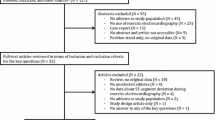Summary
The index of exercises-induced amplitude changes in a combination of Q, R and S waves, named Athens score, was tested in 213 patients, who underwent coronary angiography within 3 days of a maximal exercise test. Of the 155 cases with conclusive exercise test results, according to the coronary angiography document, 23 (14.8 %) were diagnosed as having no significant coronary artery disease (CAD); 27(17.4 %) as 1-vessel disease, 28(18.1 %) as 2-vessel disease and 77(49.7 %) as 3-vessel disease. The Athens score for them was 4.87±2.89, 0.02±3. 35, −1.70±3.68, −1.75±3.98 respectively,F = 19.65,P<0.01. An Athens score of 2 mm predicted CAD with sensitivity of 84.9 % and specificity of 78.3 % both being higher than those of ST segment depression (75.0% and 60.9 %. It was concluded that the Athens score was a promising index for improving the efficiency of exercise test to predict CAD.
Similar content being viewed by others
References
Gianrossi Ret al. Exercise induced ST depression in the diagnosis of coronar artery disease. A Meta-Analysis circulation, 1989; 80(1):87
Dagnais G Ret al. Survive of patients with a strongly positive exercise electrocardioagram. Circulation, 1982; 65(3):452
Kligfield Pet al. Evaluation of coronary artery disease by an improved method of exercise electrocardiography:The ST segment /heart slope. Am Heart J, 1986; 112(2):589
Elamin M Set al. Prediction of severity of coronary artery disease using slope of submaximal ST segment/ heart rate relationship. Cardiovasc Res, 1980; 14:681
Watanabe Met al. Clinical significance of simple heart rate adjusted ST segment depression in supine leg exercise in the diagnosis of coronary artery disease. Am Heart J, 1990; 120:1102
Lechterman Bet al. Comparison of ST segment/heart rate index to standard ST criteria for analysis of exercise electrocardiogram. Circulation, 1990; 82:44
Morales-Ballejo Het al. Septal Q wave in exercise testing; Angiographic correlation. Am J Cardiol, 1981; 48:247
Bonoris Pet al. Significance of changes in R-wave amplitude during treadmill stress testing Angiographic corelation. Am J Cardiol, 1987; 4l:846
Voyles WFet al. Directional variability in the R wave response during serial exercise testing in patients with coronary artry disease. Am Heart J, 1984; 108:983
Glazier J Jet al. Increase in S-wave amplitude during ischemic ST-segment depression in stable angina pectoris. Am J Cardiol, 1987; 59:1295
Andreas Pet al. New coronary artery disease index based on exercise induced QRS changes. Am heart J, 1990; 120:292
Hanley J Aet al. The meaning and use of the area under a receiver operating characteristic (ROC) curve. Diagn Radiol, 1982; 143:29
Hopkirk T A Cet al. Limitation of exercise induced R wave amplitude changes in detecting coronary artery disease in asymptomatic men. J AM coll Cardiol, 1984; 3:821
Fox Ket al. Inability of exercise incuced R wave changes to predict coronary artery disease. Am J Cardiol, 1982; 49:674
John D Fet al. Rate-Dependent bundle branch block: occurrence, causes and clinical correlation. J Am Coll Cardiol, 1990; 16:240
Author information
Authors and Affiliations
Rights and permissions
About this article
Cite this article
Zai-ying, L., HausØ, S. Evaluation of exercise-induced QRS amplitude changes (Athens score) and their clinical value. Journal of Tongji Medical University 13, 177–182 (1993). https://doi.org/10.1007/BF02886512
Received:
Issue Date:
DOI: https://doi.org/10.1007/BF02886512




